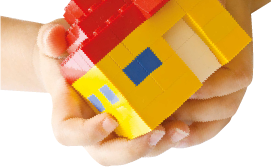Traditionally Lego® has been viewed as a toy, however this is not necessarily the case anymore. Lego is increasingly being used as a tool to encourage and develop creativity, improve language and communication and teach and enhance team building skills. I have used it with all ages, in schools, homes and businesses. I’ve also seen it used incredibly well as a tool to teach STEM (Science, Technology, Engineering and Maths) and a box of these colourful bricks can more often than not be found hiding away in a cupboard in most schools!

Building blocks for communication
Lego is great for those who like structure, predictability and rules in which to explore their creativity and construct their thoughts. Lego provides a way for those who struggle to communicate to do so. It is not just their ideas that they are able to communicate but also their thoughts, perceptions and processes. The activities help promote different types of communication: technical language, social and emotional communication and social interactive skills. Each activity has an aim – a speech, language or communication goal – but the ‘process’ and the ‘feel’ of the activities are strictly informal and fun.
Here are a few activities to try with individuals and groups:
Lego to help conversation
There is no doubt that young people are more likely to relax sooner and start chatting more confidently if they have Lego bricks in their hands. Think of Lego on these occasions as a processing tool. Some people process thoughts better if they are ‘doing’ whilst talking.
- Put a pile of Lego on the table/floor
- Start to build and encourage those with you to build anything they like
- When ready, start a conversation. Keep focused on the Lego and don’t worry about long pauses or needing to do this a few times before the chat gets going
Lego for playing together
Sort it
- Put a pile of Lego on the table/floor
- Explain you are going to sort it
- Encourage discussion around how to sort. Point out there is not a ‘right’ or ‘wrong’ way to sort Lego, and there may be different ideas. Examples may be by colour, shape, number of studs, etc
- Start sorting together, discussing the pieces and which piles/boxes they should go in
- Use visual cards if needed to distinguish the different criteria for sorting
Listen and Build
- Put a pile of Lego on the table/floor
- Have instructions on a piece of paper or card. Start simple, e.g. build a model using 3 blue bricks, 8 red bricks and 2 bricks with four studs on
- Each person gets to create and read out the instructions for the rest of the group. You may decide to give ‘awards’ for the most creative models
Lego for sharing thoughts and feelings
Many children experience sensory overload in the school environment. This can make concentration very difficult and their experiences of the classroom overwhelming. A lot of the children may not be able to express how they are experiencing an environment and in some cases they don’t realise that their experience is any different to that of their peers. Getting them to build their classroom in Lego can help them communicate their experiences. Put a pile of Lego on the table and explain to the child they will be building their classroom.
Ask them to:
- Make tables for the children and a desk for where the teacher sits. Help them if needed
- Take some Minifigures and ask the child to pick one which represents them, their teacher/friends/support staff
- Put their Minifigure in the place they feel most comfortable in the classroom
- Explain their reasons for their choice
- Put the Minifigure of the person who most makes them feel ok next to their Minifigure
- Put themselves in the model where they feel least comfortable/ok
Continue with this explorative questioning to help the child express their experiences and feelings. It will help you understand the issues and start the conversation to find solutions.
Lego is a great, simple, fun tool to support communication – why not give it a go?
Top tips for your activities:
- Think of it as structured play – know what you want to teach but keep it fun
- Allow time to learn – repeating activities will increase confidence
- Keep activities short initially, increasing the length of time as they become familiar
- Adapt for your group – there is no ‘right’ way
- Include free play as well as structured activities
- Give the children some control – play their games their way!
- Model it – do it first to show the children what to expect
- Make sure you evidence and show impact. We provide regular training on how to do this with your personalised sessions (see blockbus.co.uk)
Read Amy’s full article in The Blog at www.speechandlanguage.info
Amy Eleftheriades is a qualified teacher specialising in Autism and Social Communication difficulties. Find out more at her website: www.blockbus.co.uk
Please login to view this content
Login